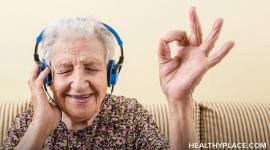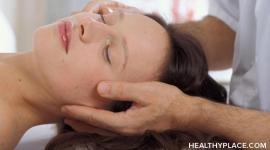Autogenic Therapy for Peace of Mind
Learn about Autogenic Therapy, a deep relaxation technique for treatment of anxiety, stress and depression.
Before engaging in any complementary medical technique, you should be aware that many of these techniques have not been evaluated in scientific studies. Often, only limited information is available about their safety and effectiveness. Each state and each discipline has its own rules about whether practitioners are required to be professionally licensed. If you plan to visit a practitioner, it is recommended that you choose one who is licensed by a recognized national organization and who abides by the organization's standards. It is always best to speak with your primary health care provider before starting any new therapeutic technique.
Background
Autogenic therapy uses visual imagery and body awareness to promote a state of deep relaxation. A detached but alert state of mind called "passive concentration" must be achieved for autogenic therapy exercises to be carried out. People participating in autogenic therapy are taught relaxation and body awareness techniques. It is believed that these approaches can then be used lifelong to promote a more healthy lifestyle, allowing people to call on their own capacity for self healing and stress reduction.
Autogenic therapy was developed in the 20th century by Dr. Johannes Schultz, a psychiatrist and neurologist. Dr. Shultz was influenced by the research of Professor Oscar Vogt, a psychiatrist and neurophysiologist who studied psychosomatic medicine. In the 1940s, Dr. Wolfgang Luthe added repetitive therapeutic suggestions to the autogenic technique.
Theory
In autogenic therapy, achievement of a detached but alert state of mind called "passive concentration" is thought to bring about physical changes. Supporters of this technique assert that autogenic therapy enhances healing and the recuperative powers of the body. Autogenic therapy has been said to rebalance mental faculties and bring closer harmony between the hemispheres of the brain.
Autogenic therapy consists of six basic focusing techniques:
- Heaviness in the limbs
- Warmth in the limbs
- Cardiac regulation
- Centering on breathing
- Warmth in the upper abdomen
- Coolness in the forehead
These techniques are based on autosuggestion; in this way, autogenic therapy is similar to meditation or self-hypnosis. A person using autogenic therapy assumes a comfortable position, concentrates on a goal and uses visual imagination and verbal cues to relax the body. Autogenic therapy may involve imagining a peaceful place followed by focusing on different physical sensations, moving from the feet to the head.
The possible mechanism of action of autogenic therapy is not fully understood. It has been suggested that it works in ways similar to hypnosis or biofeedback.
Evidence
Scientists have studied autogenic therapy for the following health problems:
Gastrointestinal conditions
Preliminary research reports some improvements in gastrointestinal disorders (constipation, diarrhea, gastritis, stomach ulcers, stomach ache, chronic nausea and vomiting or spasm), although more studies are necessary before a recommendation can be made. Patients with ulcers should be evaluated by a health care provider.
Cardiovascular conditions
Initial studies suggest possible benefits of autogenic therapy in people with heart or blood vessel disorders (palpitations, irregular heartbeat, high blood pressure, cold hands or feet). However, this research is preliminary, and additional studies are necessary before a conclusion can be made. Patients with these potentially severe conditions should be evaluated by a health care provider.
Anxiety, stress, depression
Studies of autogenic therapy for anxiety report mixed results, and it is not clear if there is any benefit. For example, one randomized controlled trial suggests autogenic training may play a role in reducing anxiety in patients undergoing coronary angioplasty (catheterization). Another randomized controlled trial found cancer patients receiving autogenic training to have an improvement in stress levels. Early evidence suggests that autogenic therapy may not be an appropriate treatment for depression.
HIV/AIDS
Some researchers have reported improvements in HIV complications, including decreased pain, night sweats, weight loss and diarrhea. There are also controversial reports of longer survival, although these findings were noted before the current era of HAART (highly active antiretroviral therapy), which has significantly lengthened survival time in HIV. Research in these areas is not conclusive, and further studies would be helpful.
Hyperventilation
Early evidence reports some benefits of autogenic therapy in people who hyperventilate, although further research is necessary before a firm conclusion can be drawn.
Behavior problems
Preliminary research suggests autogenic relaxation may reduce stress and psychosomatic complaints in children and adolescents. Further research is needed before clear recommendations can be made.
Other
Autogenic therapy has been studied for a number of other conditions, including asthma, eczema, glaucoma, headache (migraine and tension), facial pain (myofascial paid disorders) and thyroid disease. This research is early and is not conclusive. More research would be helpful in these areas.
Unproven Uses
Autogenic therapy has been suggested for many other uses, based on tradition or on scientific theories. However, these uses have not been thoroughly studied in humans, and there is limited scientific evidence about safety or effectiveness. Some of these suggested uses are for conditions that are potentially life-threatening. Consult with a health care provider before using autogenics for any use.
| Angina Anorexia Asthma Behavioral problems Biliary disorders Bladder disorders Blepharospasm (involuntary winking) Blushing Brain injury Cancer Cerebral palsy Chronic fatigue syndrome Chronic pain Circulation disorders Decreased need for pain medication Degenerative joint disease Diabetes Dyspepsia Eating disorders Enhanced athletic performance Enhanced creativity Enhanced healing Epilepsy Exercise performance Facial spasm Food allergy Grief Headache High cholesterol Improved concentration Improved performance at work Improved stress hormone levels Increased survival time in illnesses Infertility Insomnia | Irritable bowel syndrome Ischemic heart disease Jet lag Joint pain Longevity Low back pain Muscle tension Nervous cough Neuralgia (nerve pain) Night sweats Obesity Pain Panic disorder Parkinson's disease Phantom limb pain Phobias Post-traumatic stress disorder Premenstrual syndrome Pregnancy Psychotherapy Quality of life Raynaud's disease Recovery from heart attack Recurrent infections Reduced heart attack risk Rheumatoid arthritis Sexual dysfunction Sleep disorders Stress-related disorders Tranquilizer addiction Tremor Ulcerative colitis Ventricular (heart) arrhythmias Weight loss Wound healing |
Potential Dangers
Autogenic therapy is thought to be safe for most people, although safety has not been thoroughly studied. Some people may experience a sharp increase or decrease in blood pressure when they do autogenic therapy exercises. If you have abnormal blood pressure or a heart condition, or if you are taking blood pressure drugs, speak with your health care provider before starting autogenic therapy.
Before beginning a program to learn autogenic therapy, have a physical exam and discuss possible physiological effects with your health care provider. If you have a potentially severe health condition such as diabetes, heart disease or high or low blood pressure, practice autogenic therapy only under the supervision of a qualified health care provider.
Autogenic therapy should not replace more proven treatments (for example, prescription drugs, diet or lifestyle changes) for severe illnesses. Autogenic therapy is not recommended for children younger than 5 or for people with severe mental or emotional disorders. If you become anxious or restless during or after autogenic therapy exercises, stop autogenic therapy or continue only under the supervision of a professional autogenic therapy instructor.
Summary
Autogenic therapy has been recommended for many conditions. There is early evidence suggesting benefits in some cardiovascular and gastrointestinal disorders. However, there is no definitive scientific evidence that supports the use of autogenic therapy for any condition. Autogenic therapy is generally regarded as safe in most people, although it may not be advisable in young children and patients with emotional disturbances. Blood pressure changes may occur during autogenic therapy, and people with heart disease should speak with a health care provider before starting therapy.
The information in this monograph was prepared by the professional staff at Natural Standard, based on thorough systematic review of scientific evidence. The material was reviewed by the Faculty of the Harvard Medical School with final editing approved by Natural Standard.
Resources
- Natural Standard: An organization that produces scientifically based reviews of complementary and alternative medicine (CAM) topics
- National Center for Complementary and Alternative Medicine (NCCAM): A division of the U.S. Department of Health & Human Services dedicated to research
Selected Scientific Studies: Autogenic Therapy
Natural Standard reviewed more than 330 articles to prepare the professional monograph from which this version was created.
Some of the more recent studies are listed below:
- Ar'kov VV, Bobrovnitskii IP, Zvonikov VM. Complex correction of functional state in subjects with psychoautonomic syndrome [Article in Russian]. Vopr Kurortol Fizioter Lech Fiz Kult 2003;Mar-Apr, (2):16-19.
- Blanchard EB, Kim M. The effect of the definition of menstrually-related headache on the response to biofeedback treatment. Appl Psychophysiol Biofeedback 2005;30(1):53-63.
- Deter HC, Allert G. Group therapy for asthma patients: a concept for the psychosomatic treatment of patients in a medical clinic. A controlled study. Psychother Psychosom 1983;40(1-4):95-105.
- Devineni T, Blanchard EB. A randomized controlled trial of an internet-based treatment for chronic headache. Behav Res Ther 2005;43(3):277-292.
- Ehlers A, Stangier U, Gieler U. Treatment of atopic dermatitis: a comparison of psychological and dermatological approaches to relapse prevention. J Consult Clin Psychol 1995;63(4):624-635.
- El Rakshy M, Weston C. An investigation into the possible additive effects of acupuncture and autogenic relaxation in the management of chronic pain. Acupunct Med 1997;15(2):74.
- Ernst E, Kanji N. Autogenic training for stress and anxiety: a systematic review. Complement Ther Med 2000;8(2):106-110.
- Ernst E, Pittler MH, Stevinson C. Complementary/alternative medicine in dermatology: evidence-assessed efficacy of two diseases and two treatments. Am J Clin Dermatol 2002;3(5):341-348.
- Farne M, Corallo A. Autogenic training and signs of distress: an experimental study. Boll Soc Ital Biol Sper 1992;68(6):413-417.
- Galovski TE, Blanchard EB. Hypnotherapy and refractory irritable bowel syndrome: a single case study. Am J Clin Hypn 2002;Jul, 45(1):31-37.
- Goldbeck L, Schmid K. Effectiveness of autogenic relaxation training on children and adolescents with behavioral and emotional problems. J Am Acad Child Adolesc Psychiatry 2003;42(9):1046-1054.
- Gordon JS, Staples JK, Blyta A, et al. Treatment of posttraumatic stress disorder in postwar Kosovo high school students using mind-body skills groups: a pilot study. J Trauma Stress 2004;17(2):143-147.
- Groslambert A, Candau R, Grappe F, et al. Effects of autogenic and imagery training on the shooting performance in biathlon. Res Q Exerc Sport 2003;74(3):337-341.
- Gyorik SA, Brutsche MH. Complementary and alternative medicine for bronchial asthma: is there new evidence? Curr Opin Pulm Med 2004;10(1):37-43.
- Henry M, de Rivera JL, Gonzalez-Martin IJ, et al. Improvement of respiratory function in chronic asthmatic patients with autogenic therapy. J Psychosom Res 1993;37(3):265-270.
- Galovski TE, Blanchard EB. Hypnotherapy and refractory irritable bowel syndrome: a single case study. Am J Clin Hypn 2002 Jul;45(1):31-37.
- Essential hypertension and stress. When do yoga, psychotherapy and autogenic training help? [Article in German]. MMW Fortschr Med 2002;May 9, 144(19):38-41.
- Hidderley M, Holt M. A pilot randomized trial assessing the effects of autogenic training in early stage cancer patients in relation to psychological status and immune system responses. Eur J Oncol Nurs 2004;8(1):61-65.
- Huntley A, White AR, Ernst E. Relaxation therapies for asthma: a systematic review. Thorax 2002;Feb, 57(2):127-131.
- Ikezuki M, Miyauchi Y, Yamaguchi H, Koshikawa F. Development of Autogenic Training Clinical Effectiveness Scale (ATCES) [Article in Japanese]. Shinrigaku Kenkyu 2002;Feb, 72(6):475-481.
- Kanji N, White AR, Ernst E. Autogenic training reduces anxiety after coronary angioplasty: a randomized clinical trial. Am Heart J 2004;147(3):E10.
- Kanji N. Management of pain through autogenic training. Complement Ther Nurs Midwifery 2000;6(3):143-148.
- Kanji N, White AR, Ernst E. Anti-hypertensive effects of autogenic training: a systematic review. Perfusion 1999;12:279-282.
- Kermani KS. Stress, emotions, autogenic training and aids. Br J Holist Med 1987;2:203-215.
- Kircher T, Teutsch E, Wormstall H, et al. Effects of autogenic training in elderly patients [Article in German]. Z Gerontol Geriatr 2002;Apr, 35(2):157-165.
- Kornilova LN, Cowings P, Arlashchenko NI, et al. Individual characteristics of correction of the cosmonauts' vegetative status with a method of adaptive biofeedback [Article in Russian]. Aviakosm Ekolog Med 2003;37(1):67-72.
- Labbe EE. Treatment of childhood migraine with autogenic training and skin temperature biofeedback: a component analysis. Headache 1995;35(1):10-13.
- Legeron P. Stress psychology and the role of stress management [Article in French]. Ann Cardiol Angeiol (Paris) 2002;Apr, 51(2):95-102.
- Linden W. Autogenic training: a narrative and quantitative review of clinical outcome. Biofeedback Self Regul 1994;19(3):227-264.
- Matsuoka Y. Autogenic training [Article in Japanese]. Nippon Rinsho 2002;Jun, 60(Suppl 6):235-239.
- O'Moore AM, O'Moore RR, Harrison RF, et al. Psychosomatic aspects in idiopathic infertility: effects of treatment with autogenic training. J Psychosom Res 1983;27(2):145-151.
- Perlitz V, Cotuk B, Schiepek G, et al. [Synergetics of hypnoid relaxation]. Psychother Psychosom Med Psychol 2004;54(6):250-258.
- Rashed H, Cutts T, Abell T, et al. Predictors of response to a behavioral treatment in patients with chronic gastric motility disorders. Dig Dis Sci 2002;May, 47(5):1020-1026.
- Simeit R, Deck R, Conta-Marx B. Sleep management training for cancer patients with insomnia. Support Care Cancer 2004;12(3):176-183.
- Stetter F. A review of controlled studies with autogenic training. Curr Opin Psych 1999;12(Suppl 1):162.
- Stetter F, Kupper S. Autogenic training: a meta-analysis of clinical outcome studies. Appl Psychophysiol Biofeedback 2002;Mar, 27(1):45-98.
- ter Kuile MM, Spinhoven P, Linssen AC, et al. Autogenic training and cognitive self-hypnosis for the treatment of recurrent headaches in three different subject groups. Pain 1994;58(3):331-340.
- Unterberger PG. High blood pressure and renal lesions: curable with hypnosis? [Article in German]. MMW Fortschr Med 2002;Feb 28, 144(9):12.
- Watanabe Y, Cornelissen G, Watanabe M, et al. Effects of autogenic training and antihypertensive agents on circadian and circaseptan variation of blood pressure. Clin Exp Hypertens 2003;25(7):405-412.
- Winocur E, Gavish A, Emodi-Perlman A, et al. Hypnorelaxation as treatment for myofascial pain disorder: a comparative study. Oral Surg Oral Med Oral Pathol Oral Radiol Endod 2002;Apr, 93(4):429-434.
- Wright S, Courtney U, Crowther D. A quantitative and qualitative pilot study of the perceived benefits of autogenic training for a group of people with cancer. Eur J Cancer Care (Engl) 2002;Jun, 11(2):122-130.
- Zsombok T, Juhasz G, Budavari A, et al. Effect of autogenic training on drug consumption in patients with primary headache: an 8-month follow-up study. Headache 2003;Mar, 43(3):251-257.
back to: Alternative Medicine Home ~ Alternative Medicine Treatments
APA Reference
Staff, H.
(2008, October 30). Autogenic Therapy for Peace of Mind, HealthyPlace. Retrieved
on 2025, December 31 from https://www.healthyplace.com/alternative-mental-health/treatments/autogenic-therapy-for-peace-of-mind


